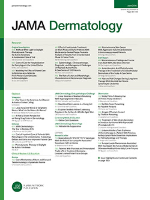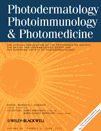
JOURNAL OF INVESTIGATIVE DERMATOLOGY
Scope & Guideline
Transforming Insights into Dermatological Breakthroughs
Introduction
Aims and Scopes
- Molecular and Cellular Mechanisms in Skin Biology:
Research focusing on the molecular and cellular underpinnings of skin function, including keratinocyte biology, immune responses, and the role of various cell types in skin health and disease. - Skin Diseases and Disorders:
Studies addressing the pathophysiology, epidemiology, and treatment of various skin conditions, including psoriasis, atopic dermatitis, skin cancers, and autoimmune blistering diseases. - Therapeutic Innovations and Clinical Trials:
Exploration of new therapeutic approaches, including the efficacy and safety of biologic agents, small molecules, and novel drug delivery systems in treating dermatological conditions. - Skin Microbiome and Its Role in Dermatology:
Investigations into the skin microbiome's influence on skin health, disease, and therapeutic responses, highlighting the complex interactions between skin-resident microorganisms and host immunity. - Genetics and Genomics in Dermatology:
Research on the genetic and epigenetic factors contributing to skin diseases, including the identification of biomarkers for disease susceptibility, progression, and treatment outcomes. - Environmental and Lifestyle Factors in Skin Health:
Studies examining how environmental factors, lifestyle choices, and systemic conditions impact skin health, disease onset, and treatment efficacy.
Trending and Emerging
- Single-Cell and Spatial Transcriptomics:
There is a growing emphasis on single-cell RNA sequencing and spatial transcriptomics to dissect the cellular heterogeneity and immune microenvironments in various skin diseases, providing insights into disease mechanisms and treatment responses. - Immunotherapy and Immune Modulation:
Research on immune checkpoint inhibitors and biologics targeting specific pathways in skin diseases is rapidly expanding, focusing on their mechanisms of action and patient response variability. - Microbiome Research in Dermatology:
The role of the skin microbiome in health and disease is gaining attention, with studies exploring how microbial communities influence skin conditions and responses to treatments. - Advanced Imaging Techniques:
Innovations in imaging technologies, such as multiphoton microscopy and reflectance confocal microscopy, are increasingly being utilized to enhance diagnostic accuracy and monitor treatment outcomes in dermatology. - Genetic and Genomic Profiling:
The integration of genetic and genomic approaches to understand skin diseases is on the rise, including the identification of genetic variants associated with disease susceptibility and treatment efficacy. - Artificial Intelligence in Dermatology:
The application of AI and machine learning for diagnostics, treatment planning, and patient management is emerging as a significant trend, transforming how dermatological research and clinical practice are conducted.
Declining or Waning
- Traditional Dermatologic Therapies:
Research on conventional topical and systemic treatments has waned as newer biologics and targeted therapies gain traction, leading to a shift in focus towards innovative therapeutic approaches. - Basic Histopathology Studies:
The prevalence of purely histopathological studies without integrated molecular or genetic analysis has decreased, as the field moves towards more comprehensive approaches that combine histopathology with molecular insights. - General Dermatological Education and Training:
Research addressing basic dermatological education has seen less emphasis, reflecting a growing focus on specialized training and the integration of advanced technologies such as AI in dermatology. - Animal Models of Skin Disease:
The reliance on traditional animal models for skin disease research is declining, with an increasing emphasis on humanized models and in vitro systems that better mimic human skin conditions.
Similar Journals

Dermatopathology
Fostering collaboration for a deeper understanding of skin pathology.Dermatopathology is a pioneering open-access journal dedicated to the field of skin pathology, published by MDPI in Basel, Switzerland. Since its inception in 2014, the journal has provided a vital platform for the dissemination of cutting-edge research, advancements, and clinical studies that aid in the understanding of dermatological diseases at the microscopic level. With its commitment to accessibility and wide-ranging contributions from international researchers, Dermatopathology serves as an essential resource for dermatologists, pathologists, and academics alike. The journal strives to foster innovative collaborations and enhance knowledge within the multidisciplinary sphere of dermatology and pathology, ensuring timely access to valuable information that can influence clinical practices and improve patient outcomes. Researchers are encouraged to submit their original articles, case reports, and reviews, contributing to the growing body of knowledge essential for advancing the field.

JOURNAL OF DERMATOLOGICAL SCIENCE
Leading the Charge in Skin ResearchThe Journal of Dermatological Science is a premier peer-reviewed publication dedicated to advancing knowledge in the field of dermatology, biochemistry, and molecular biology. Established in 1990 and published by Elsevier Ireland Ltd, this esteemed journal has consistently achieved high academic recognition, securing a Q1 ranking in Dermatology and a Q2 ranking in both Biochemistry and Molecular Biology as of 2023. With a notable impact factor and a Scopus rank that places it within the top tier of dermatology journals globally, it serves as a critical platform for researchers, clinicians, and academicians to disseminate their findings and foster innovation in skin health and disease management. Although the journal is not open access, it provides essential insights into cutting-edge research, clinical practices, and molecular mechanisms underlying dermatological conditions. The Journal of Dermatological Science is not only a vital resource for high-quality articles but also a driving force in shaping the future landscape of dermatological research.

Turkderm-Turkish Archives of Dermatology and Venerology
Empowering Dermatology with Unrestricted KnowledgeTurkderm - Turkish Archives of Dermatology and Venerology, published by GALENOS PUBL HOUSE, serves as a vital platform for the dissemination of innovative research and advancements in the fields of dermatology and venerology. With an Open Access policy implemented since 2002, this journal aims to provide free and unrestricted access to significant findings, ensuring that vital information reaches a global audience. Based in Turkey, the journal has positioned itself as an important resource for professionals, researchers, and students alike, despite currently being categorized in Q4 of both Dermatology and Infectious Diseases as per the 2023 metrics. Although it faces competition in the rankings, with a Scopus standing of #131 in Dermatology and #331 in Infectious Diseases, its dedication to advancing knowledge in these critical health areas is unwavering. The journal continually invites original research, reviews, and case studies that enhance clinical practices and foster understanding in the dermatological community.

AMERICAN JOURNAL OF CLINICAL DERMATOLOGY
Transforming Patient Care through Innovative DiscoveriesThe American Journal of Clinical Dermatology, published by Adis International Ltd, is a leading peer-reviewed journal dedicated to advancing the field of dermatology. With a notable impact factor and a prestigious Q1 rank in both Dermatology and Miscellaneous Medicine categories, this journal stands out as a valuable resource for researchers and clinicians alike, offering cutting-edge insights into clinical practice and innovative treatment strategies. Its comprehensive scope encompasses a broad range of topics within dermatology, addressing both common and rare conditions, with a focus on emerging therapies and technologies. As it converges its publication years from 2000 to 2024, the journal remains an essential platform for disseminating high-quality research to professionals striving to improve patient care and outcomes. With the ISSN 1175-0561 and E-ISSN 1179-1888, the American Journal of Clinical Dermatology facilitates greater accessibility to pivotal findings within the field, making it an indispensable resource for anyone involved in dermatological research and practice.

JOURNAL OF DERMATOLOGY
Shaping the future of skin health through impactful research.The Journal of Dermatology, published by Wiley, is a premier academic journal dedicated to advancing the field of dermatology, with its esteemed reputation reflected in its Q1 ranking in Dermatology and a remarkable Q2 ranking in Miscellaneous Medicine as of 2023. Since its inception in 1974, the journal has become a vital resource for researchers, clinicians, and students alike, covering pioneering studies and cutting-edge advancements in skin health and disease. With a Scopus rank of #32 out of 142 in the Dermatology category, placing it in the 77th percentile, the journal underscores its commitment to fostering knowledge and innovation within the dermatological community. Although the journal operates under a subscription model, it remains an essential platform for disseminating impactful research that shapes clinical practice and enhances patient care. For anyone invested in dermatological sciences, Journal of Dermatology serves as a key publication where critical insights and developments are regularly showcased.

Dermatologie
Pioneering Insights in Dermatological ScienceDermatologie, published by SPRINGER HEIDELBERG, is a prominent journal dedicated to the advancing field of dermatology. With its ISSN 2731-7005 and E-ISSN 2731-7013, this journal has established itself as a valuable resource for researchers, professionals, and students alike. Originating in Germany, the journal focuses on disseminating innovative research from 2022 to 2024, contributing significantly to the understanding of skin health and disease management. Despite its current ranking within the Q3 category in dermatology and a Scopus rank of #88/142, it provides critical insights and advances in clinical practice, epidemiology, and therapeutic modalities. With an emphasis on open discourse, it seeks to foster collaboration among healthcare professionals and researchers, thereby enhancing the quality and accessibility of dermatological research. Engage with Dermatologie to stay at the forefront of the latest advancements in skin-related health issues.

ANNALES DE DERMATOLOGIE ET DE VENEREOLOGIE
Exploring New Horizons in Dermatology and VenereologyANNALES DE DERMATOLOGIE ET DE VENEREOLOGIE is a distinguished journal that serves as a vital platform for disseminating innovative research and insightful reviews in the field of dermatology and venereology. Published by MASSON EDITEUR, this journal has been a cornerstone for professionals and researchers since its inception in 1977, offering a wealth of knowledge that spans decades. With its ISSN 0151-9638 and E-ISSN 2214-5451, it is indexed within leading databases, ensuring that the published work reaches a broad audience. The journal currently holds a Q3 ranking in the dermatology category, reflecting its commitment to quality and rigorous peer-review processes. While the journal is not open access, it provides an extensive archive of valuable studies that contribute to advancements in skin health and treatment methodologies. Located in Issy-les-Moulineaux, France, ANNALES DE DERMATOLOGIE ET DE VENEREOLOGIE continues to attract submissions from esteemed professionals, enhancing its reputation as a crucial resource for those dedicated to the ongoing development of dermatological sciences.

AMERICAN JOURNAL OF DERMATOPATHOLOGY
Connecting Academia and Clinical Practice in DermatopathologyAMERICAN JOURNAL OF DERMATOPATHOLOGY, published by Lippincott Williams & Wilkins, is an essential resource for professionals and researchers engaged in the fields of dermatology, pathology, and forensic medicine. Established in 1979, the journal aims to disseminate cutting-edge research and advancements pertaining to the microscopic examination of skin disorders. With an esteemed impact factor that positions it well within the Q3 category of dermatology and pathology as of 2023, the journal ranks #81 out of 142 in dermatology and #130 out of 208 in pathology according to Scopus. Although it does not currently offer open access options, the journal provides valuable insights and substantial contributions to the understanding of dermatopathology, making it a vital tool for academics, clinicians, and students seeking to stay abreast of the latest findings and practices in the field. Its commitment to high-quality research continues to foster a deeper understanding of skin diseases, enhancing patient care and scientific inquiry alike.

JAMA Dermatology
Transforming Skin Health Through Cutting-Edge Research.JAMA Dermatology, an esteemed publication by the American Medical Association, is positioned at the forefront of dermatological research and clinical practice. With an ISSN of 2168-6068 and an E-ISSN of 2168-6084, this journal underscores a commitment to disseminating high-quality and impactful research within the field. Notably ranked Q1 in both Dermatology and Miscellaneous Medicine for 2023, JAMA Dermatology ranks among the top journals in its category, holding the impressive 3rd position out of 142 in Scopus's dermatology rankings, placing it in the 98th percentile. With converged years extending from 2013 to 2024, the journal emphasizes timely and critical advancements in dermatological science. Furthermore, as a champion of open access, it encourages a broad dissemination of knowledge, making essential research accessible to a wider audience. Researchers, professionals, and students alike will find JAMA Dermatology to be an invaluable resource for the latest findings, innovative therapies, and in-depth reviews that shape the future of dermatological health.

PHOTODERMATOLOGY PHOTOIMMUNOLOGY & PHOTOMEDICINE
Illuminating the Intersection of Skin Health and SciencePHOTODERMATOLOGY PHOTOIMMUNOLOGY & PHOTOMEDICINE, published by WILEY, is a leading academic journal dedicated to the interdisciplinary study of skin-related health issues, particularly focusing on the impacts of ultraviolet light as well as the immunological and therapeutic aspects of photomedicine. With a rich publication history dating back to 1990 and a commitment to advancing knowledge in its field, this journal serves as a vital resource for researchers and professionals working in dermatology, immunology, and related disciplines. Recognized for its high impact, it has achieved a Q1 classification in Dermatology and holds robust rankings in several other categories, reflecting its strong contribution to scholarly discourse. Although it does not currently operate as an Open Access publication, PHOTODERMATOLOGY PHOTOIMMUNOLOGY & PHOTOMEDICINE remains crucial for disseminating essential findings and innovations, particularly for those involved in studies exploring the intersections of skin health, immune response, and therapeutic technologies.